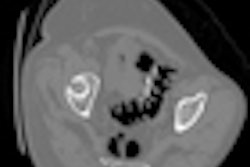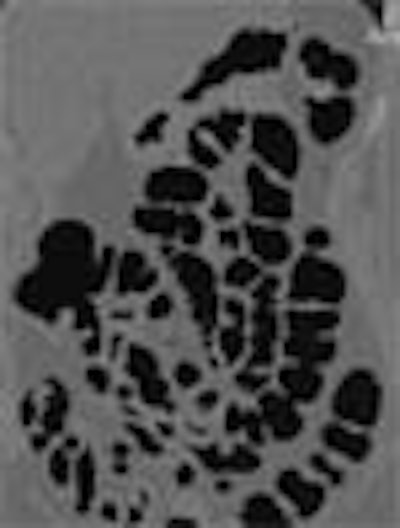
The vagus or "wandering" nerve begins in the brain stem -- the medulla oblangata to be precise -- and wends its way down to the abdomen, affecting every organ in its path. Among other things, the vagus is involved in esophageal and laryngeal movements, and in involuntary processes such as sweating, heartbeat, breathing, and peristalsis.
The longest and by far most important of the cranial nerves, the vagus nerve supplies both motor and sensory nerve fibers to the mouth, neck and throat muscles, and even the transverse colon.
Vasovagal reactions, which can result from overstimulation of the nerve, are a phenomenon best avoided. Mostly transient and self-limiting, they are not always benign. Common symptoms of vasovagal reaction may include headache, nausea, weakness, or fainting; clinical effects such as vasodilation, hypotension, bradycardia, and even cardiac arrest have been reported, rarely.
Emotional trauma and certain medications can produce a reaction, as can conventional colonoscopy, which has appeared in 1% to 16% of cases in published studies.
Can vasovagal reactions be produced by virtual colonoscopy as well? Some researchers have suggested that insufflation of the colon may underlie a handful of apparent reactions seen by clinicians.
To address this question, Dr. Emanuele Neri and colleagues Drs. Paola Vagli, Dr. Francesca Vannozzi, Dr. Alex Bardine, and Dr. Carlo Bartolozzi from the University of Pisa in Italy performed a study to measure any clinical and subjective signs of vasovagal reactions in a group of VC subjects.
There were hints of vasovagal involvement among the 185 VC study subjects, the group reported at the International Symposium on Virtual Colonoscopy in Boston. However, the clinical signs of vasovagal reaction never rose to the level of clinical significance.
"Vasovagal reactions are due to the excessive activity of the vagus nerve that causes a lowering of the heart rate and the fall of blood pressure in the most serious cases," Neri said in his presentation.
A rare complication of endoscopic studies has occurred in 1% to 16% of cases as a result of bowel distension, he said. "It is believed that pain, distension of the colon, and stretching of the mesentery may stimulate the vagi sufficiently to produce a reaction," Neri said.
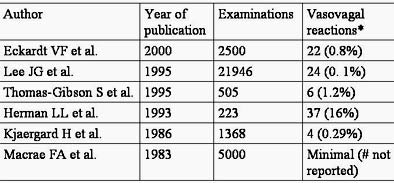 |
| Vasovagal reactions have been reported rarely in the virtual colonoscopy literature. Chart courtesy of Dr. Emanuele Neri. |
Among their screening VC cases, Neri and colleagues have seen two cases the group believes are clearly related to vasovagal reactions -- one a 65-year-old woman who had, pallor, diaphoresis, nausea, and vomiting accompanied by sustained bradycardia (30 minutes) following virtual colonoscopy insufflation. The second VC patient, a 44-year-old woman, had pallor, abdominal pain, and sustained bradycardia for 30 minutes after colonic insufflation.
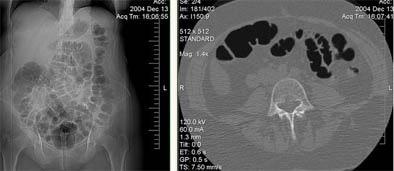 |
| A 65-year-old woman underwent follow-up VC following a right colectomy for colon cancer. The intervention three years earlier included removal of the ileocecal valve with subsequent ileocolic anastomosis. Insufflation in the supine decubitus did not cause abdominal pain. At VC the colon was normal but shows overdistension of the small bowel in the supine CT data (above) and confirmed in the prone CT data (below). Objective or subjective symptoms were not reported. Immediately after prone decubitus positioning, at the end of the exam, the patient reported headache, nausea, and stimulus to vomiting. Cold sweat and diaphoresis were also observed. All images courtesy of Dr. Emanuele Neri. |
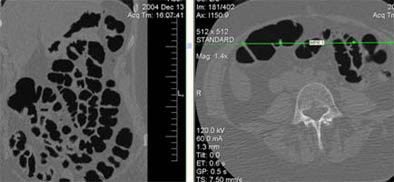 |
Based on criteria advanced in a 1993 study by Herman et al (Gastrointestinal Endoscopy, 1993, Vol. 39:3, pp. 388-91), Neri and colleagues' study defined vasovagal reaction as the occurrence of one or more of the following:
- Pallor and/or diaphoresis (objective signs)
- Nausea and/or abdominal pain (subjective signs)
- Sustained bradycardia less than 60 bpm or a decrease in heart rate of 10%
- Hypotension (systolic blood pressure less than 90 mm Hg, diastolic blood pressure less than 60 mm Hg) or a reduction in blood pressure of more than 10% below a baseline measurement obtained before pneumocolon
"We monitored for the occurrence of one of the above in 185 patients that underwent multirow CT colonography" in both prone and supine positions, Neri explained. "In each patient, CTC was performed without contrast or muscle relaxants in order to avoid the superimposition of pharmacological effects on the cardiovascular system."
Before and after insufflation, systolic and diastolic blood pressure values and heart rate were monitored in each patient. They were also evaluated for clinically objective and subjective signs of vasovagal reaction.
According to the results, no discomfort was reported in 169 of 185 patients. There were subjective signs of vasovagal reaction in 13 patients; seven had abdominal pain and nine reported nausea. Objective signs in three cases included pallor and diaphoresis, all of which occurred after prone positioning. One patient, who underwent colonic insufflation without any objective symptoms but with bradycardia, had nausea and diaphoresis at colonoscopy that was interrupted at the left colon.
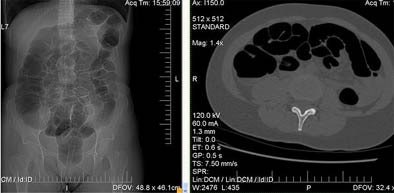 |
| A 44-year-old woman (first-degree relative of a colorectal cancer patient) underwent screening VC. Conventional colonoscopy two years earlier was incomplete due to dolichocolon. Immediately after prone decubitus positioning at the end of the exam, the patient reported abdominal pain, nausea, and stimulus to vomiting; a cold sweat was also observed. ECG did not show alterations of the cardiac cycle, blood pressure was normal, and a sustained bradycardia (50 bpm) was observed. VC data analysis confirmed the presence of dolichocolon and revealed overdistension of the small bowel in the supine (above) and in the prone decubitus positions (below). All symptoms resolved in 30 minutes. All images courtesy of Dr. Emanuele Neri. |
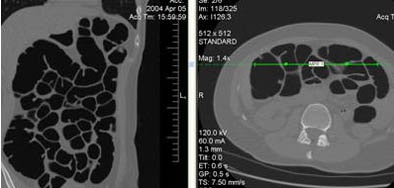 |
Monitoring of cardiac function showed a significant decrease of the heart rate (p = 0.01) that was not associated with significant variation in systolic and diastolic blood pressure values (p > 0.05). Sustained bradycardia in 43 of 185 subjects (23%) or hypotension in 32 of 185 (17%) were also observed in accordance with the study criteria, Neri said.
"In our series the incidence of objective signs referring to vasovagal reaction was quite low, while subjective manifestations were common, especially in the case of mild syncope," Neri said. "Moreover the occurrence of significant variation in cardiovascular parameters is reported in the larger literature according to the physiological response to colonic insufflation."
VC can potentially cause a mild vasovagal reaction, Neri concluded, and in the two cases reported in the group's series, it was probably due to overdistension of the small bowel associated with the prone position.
"Further work in our study will be focused on determining the relationship between the overall distension of the colon and small bowel with the subjective and objective signs of vasovagal reaction, as well as modification of blood pressure and heart rate," he said.
The group is also evaluating automated CO2 insufflation as part of this process.
By Eric Barnes
AuntMinnie.com staff writer
December 14, 2005
Related Reading
VC safe, surveys show, but not without incident, October 18, 2005
Copyright © 2005 AuntMinnie.com






